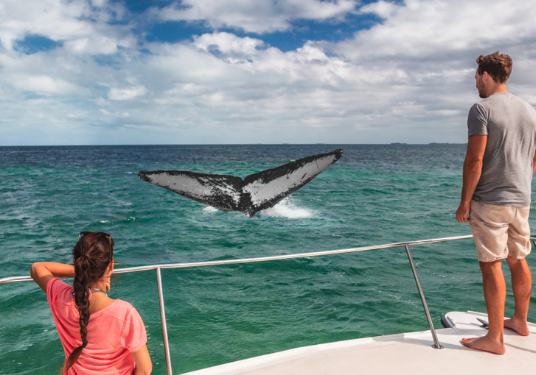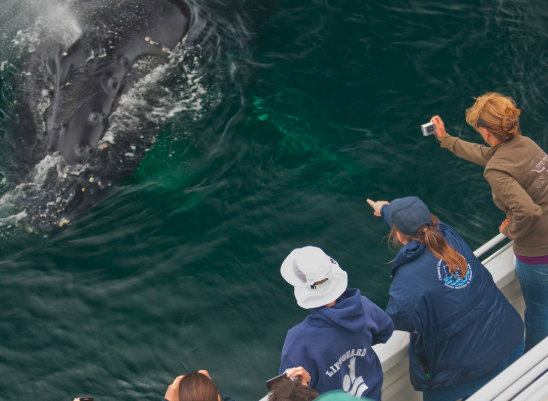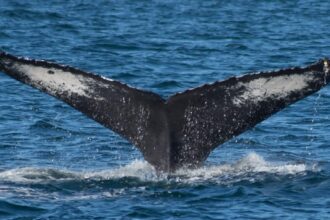When is The Best Time for Whale Watching in Puerto Vallarta

Puerto Vallarta welcomes about 26,000 humpback whales every year. These magnificent creatures arrive in Banderas Bay, creating one of the best whale-watching destinations. The gentle giants reach lengths of 55 feet and weigh up to 40 tons. They cover roughly 12,500 miles in their round trip at a steady pace of 80 miles daily.
The best time to watch whales in Puerto Vallarta starts in December and continues through March. January and February are peak months that bring 300 to 500 humpback whales to the area. Visitors should plan their trips around 8 AM because the sea remains calm and provides the best viewing conditions.
This detailed piece helps you pick the perfect time to watch whales in Puerto Vallarta. You’ll learn about seasonal patterns and get expert tips that guarantee sightings. The massive humpbacks dominate the bay’s waters, and occasional orcas pass through from January to March. These insights will help create an unforgettable whale watching experience.

Table of Contents
- 1 Understanding Puerto Vallarta Whale Season
- 2 Month-by-Month Whale Watching Guide
- 3 Best Times of Day for Whale Watching
- 4 Local Expert Tips for Guaranteed Sightings
- 5 Planning Your Whale Watching Experience
- 6 Here are some FAQs about when is the best time for whale watching in Puerto Vallarta:
- 6.1 What are the best months for whale watching in Puerto Vallarta?
- 6.2 Is whale watching worth it in Puerto Vallarta?
- 6.3 Can you see whales from shore in Puerto Vallarta?
- 6.4 What month are whales in Mexico?
- 6.5 What time of day is best to go whale watching?
- 6.6 How much does it cost to go whale watching in Puerto Vallarta?
- 6.7 What kind of whales are in Puerto Vallarta right now?
- 6.8 What month is best for Puerto Vallarta?
- 6.9 Are there killer whales in Puerto Vallarta?
- 6.10 What time of day is best for whale watching in Mexico?
- 6.11 Why do humpback whales come to Puerto Vallarta?
Understanding Puerto Vallarta Whale Season
Banderas Bay’s magnificent waters become a marine sanctuary when humpback whales begin their remarkable 5,000-kilometer trip from Arctic waters. These incredible creatures arrive by mid-November and make Puerto Vallarta their winter home until late March.
Migration patterns and timing
Nature’s timing works perfectly with seasonal changes. These marine giants spend their northern summer months feeding heavily in Arctic waters to build up their fat reserves. They swim about 80 miles each day on their way south. The Mexican Pacific welcomes six of the world’s 14 whale species, and humpback and gray whales return regularly each season.
Peak months for different whale species
Humpback whales rule these local waters. Banderas Bay sees 300 to 500 of them every year. January through February brings the best whale watching opportunities. While humpbacks steal the show, you might also spot:
- Bryde’s whales (occasional sightings)
- Orcas (sporadic appearances)
- Gray whales (seasonal visitors)
Factors affecting whale activity
The bay’s environment and biological factors shape whale behavior in Puerto Vallarta’s waters. These gentle giants find a perfect sanctuary here, safe from major predators like orcas. The water temperature stays between 22°C and 27°C, creating ideal conditions for adults and calves.
An 11-month pregnancy plays a vital role in when these whales migrate. “Nurse” whales help first-time mothers by staying with them for 5 to 6 months until they head back to Arctic waters. Baby whales can gain up to 200 pounds daily in these nurturing waters.
The bay’s deep and calm waters give mothers and calves perfect spots to rest. These magnificent creatures store up resources during summer because they barely eat during their winter stay in Puerto Vallarta’s waters. This natural pattern makes their migration timing essential to their survival and successful breeding.
Month-by-Month Whale Watching Guide
Humpback whales make their seasonal trip to Puerto Vallarta, giving visitors amazing chances to see them at different times during the whale watching season. Each month brings its own special moments, from when they first arrive until they leave.
Early season (December) expectations
The whale watching season officially starts on December 8th when the first pods arrive. Pregnant females lead the way to find warm waters where they can give birth. Whale activity picks up through December, and tour operators guarantee you’ll see whales from December 20th onward.
Peak season highlights (January-February)
January and February are the best months to watch whales in Puerto Vallarta. You’ll find:
- 300 to 500 humpbacks swimming in Banderas Bay
- Male whales showing off spectacular courtship displays
- New calves being born
- Crystal-clear water conditions for the best views
The bay becomes nature’s theater during these peak months. Male humpbacks race and bump into each other as they chase potential mates.
Late season opportunities (March)
March brings something special as the season comes to an end. Early March is a great time to see mother whales teaching their newborns important survival skills. Tours run until March 23rd, but you’ll see fewer whales as they get ready to swim north.
Tours that start at 8:30 AM give you the best viewing conditions no matter which month you choose. The calm waters and better visibility in the early hours create perfect conditions for taking photos of these amazing creatures. People who get seasick easily find morning tours much better.
February and early March are your best bet to see baby whales swimming with their parents. The winter months match Puerto Vallarta’s dry season, so there’s less chance that rain will spoil your boat trip.
Best Times of Day for Whale Watching
Timing is a vital part of watching whales along Puerto Vallarta’s coastline. Visitors can boost their chances of spotting these magnificent marine mammals by knowing daily patterns and environmental conditions.
Morning vs afternoon viewing conditions
The best time to watch whales is around 8:30 AM. The sea stays calm during these hours, which means smoother sailing and less chance of getting seasick. Expert guides suggest morning trips over afternoon tours to see whales better.
The water gets choppy from 3:00 PM to 4:00 PM when afternoon winds pick up. All the same, whales stay active all day, so both morning and afternoon tours give you good chances to spot them.
Tide and weather impact on sightings
Tides shape how whales behave and move. These water cycles create ocean currents that affect where whales go. Whales adjust their activities based on:
- Water movement during extreme tides
- Ocean current patterns
- Underwater topography
- Local weather conditions
Whales adapt to changes in their ocean home by shifting where they swim and dive. These amazing creatures show more activity during spring tides, though their underwater behavior changes with environmental conditions.
Optimal photography hours
Morning’s golden light sets up perfect shots of whales in action. People who want to capture their whale watching adventure need good preparation. Camera experts should think about:
- Telephoto lenses (70-200mm range)
- Waterproof camera protection
- Burst mode settings for unexpected breaches
- Live mode settings for mobile devices
Puerto Vallarta’s winter brings cold mornings, so dress warmly for photo sessions. Whatever time you pick for your tour, keeping your camera gear safe from water splashes is key to getting great whale photos.
Local Expert Tips for Guaranteed Sightings
You don’t always need a boat tour to watch whales in Puerto Vallarta. The city has several excellent land-based viewing spots that most visitors overlook.
Lesser-known viewing spots
The historic Malecón boardwalk lets you spot whales right from the shore. Destiladeras Beach and Nuevo Vallarta are chances to watch these magnificent creatures from oceanfront hotels and infinity pools.
Booking a room with an ocean view at beachfront hotels boosts your chances to spot whales from private balconies. The whales put on an especially impressive show during full moon nights.
Weather patterns to watch for
Weather conditions affect whale watching success by a lot. The best viewing conditions come during the dry season from December through March. The early morning hours bring calmer seas and better visibility.
Motion sickness can make or break your trip. Take motion sickness medication 30-60 minutes before departure, stay hydrated, and skip caffeine and alcohol to reduce discomfort. The boat’s middle section on the lower level has minimal motion, according to experienced guides.
Tracking whale movements
Experienced watchers know these signs of whale presence:
- Groups of boats often point to nearby whale activity
- Water plumes from blowholes mean surfacing whales
- Tail sightings above water usually mean humpback whales, which can stay underwater for up to 15 minutes
Marine biologists track whale songs with hydrophones and monitor migration patterns using GPS systems. These tools help them find preferred routes and gathering spots across Banderas Bay.
Tour operators with proper certification display special whale watching flags and follow distance rules that protect these marine mammals. Their captains know whale behavior patterns so well they can predict where these magnificent creatures might surface next.

Planning Your Whale Watching Experience
You’ll want to think over several things to make your whale watching trip in Puerto Vallarta an unforgettable experience with these magnificent marine mammals.
Choosing the right tour operator
The tour operator you pick will make the most important difference in your whale watching experience. Licensed operators must display special whale watching flags and follow proper distance rules to protect marine mammals. We grouped tours into these categories:
- Zodiac boats: Ideal for adventure seekers, offering closer encounters
- Sailboats: Perfect for peaceful viewing with maximum comfort
- Catamarans: Suitable for families and those seeking additional amenities
- Pangas: Economical options for small groups
The best operators have marine biologists or certified guides who give great explanations about whale behavior. Tours usually last 3 to 4 hours, and some operators even guarantee whale sightings between December 20th and March 1st.
Everything in gear and preparation
The right preparation will give a comfortable whale watching experience. The morning ocean air can get chilly, so you need to layer your clothing strategically. Here’s what you should pack:
- Light windbreaker or jacket
- Comfortable, slip-resistant footwear
- Sun protective clothing and biodegradable sunscreen
- Refillable water bottle
- Motion sickness medication (taken night before and day of tour)
You should arrive 45 minutes before departure time. If you get seasick easily, pick a spot near the boat’s middle section on the lower level to minimize motion effects.
Photography equipment recommendations
You need specific photography gear and techniques to capture these magnificent creatures. Professional photographers should bring telephoto lenses ranging from 70 to 200mm. Your success in whale photography depends on these key factors:
Live mode settings work well for mobile devices when capturing unexpected whale appearances. Professional cameras benefit from burst mode settings to capture breaching moments. You must protect your equipment from water exposure – keep cotton cloths handy to clean your lens between shots.
Expert photographers suggest pre-focusing at predicted spots and keeping shutter speeds above 1/500th for stability. Set your aperture between f8-11 to get enough depth of field for these massive creatures.
Banderas Bay becomes a spectacular marine theater every winter. Visitors can watch humpback whales swim and play in their natural habitat. These magnificent creatures travel thousands of miles from Arctic waters, making Puerto Vallarta one of North America’s best spots to watch whales.
The success of whale watching trips depends on good timing and preparation. Tours in the early morning from December through March give the best chances to see whales. January and February are the peak months when whale sightings are guaranteed. Visitors can choose between relaxing catamaran cruises or exciting zodiac boat rides, and licensed operators make sure everyone has a safe and memorable time with these gentle giants.
The Malecón boardwalk and Destiladeras Beach let people spot whales without getting on a boat. Photographers who know whale behavior patterns and bring the right equipment can capture amazing shots of these marine mammals as they breach, splash and play in Banderas Bay’s protected waters.
Puerto Vallarta’s whale watching season shows nature at its finest. These annual migrations fascinate wildlife enthusiasts worldwide. This piece gives you the knowledge to experience these incredible creatures in their winter sanctuary.
Here are some FAQs about when is the best time for whale watching in Puerto Vallarta:
What are the best months for whale watching in Puerto Vallarta?
The best months for whale watching in Puerto Vallarta are December through March. During this period, humpback whales migrate to the warm waters of Banderas Bay for mating and calving. If you’re wondering when is the best time for whale watching in Puerto Vallarta, these winter months provide optimal chances for spotting these magnificent creatures.
Is whale watching worth it in Puerto Vallarta?
Yes, whale watching in Puerto Vallarta is absolutely worth it. The unique opportunity to see humpback whales breaching and playing in their natural habitat is a once-in-a-lifetime experience. The tours are well-organized, often including expert guides who provide fascinating insights into marine life.
Can you see whales from shore in Puerto Vallarta?
Yes, you can occasionally see whales from the shore in Puerto Vallarta, particularly if you’re near vantage points like the Malecon or beachfront hotels. However, a dedicated whale-watching tour offers a closer and more immersive experience. This ensures the best chance to see these majestic animals up close.
What month are whales in Mexico?
In Mexico, the prime months for whale watching are December through April. This is when whales migrate to warm Pacific waters, including hotspots like Puerto Vallarta and Los Cabos. If you’re asking when is the best time for whale watching in Puerto Vallarta, mid-December to early March is ideal.
What time of day is best to go whale watching?
The best time of day for whale watching is early morning when the waters are calm and the lighting is excellent for spotting whales. Tours departing between 8 AM and 10 AM often provide the most sightings. If you’re planning to enjoy whale watching in Puerto Vallarta, booking a morning tour is highly recommended.
How much does it cost to go whale watching in Puerto Vallarta?
Whale-watching tours in Puerto Vallarta typically cost between $50 and $100 per person. The price varies based on the tour company, duration, and type of boat. For those looking to enjoy when is the best time for whale watching in Puerto Vallarta, booking in advance during the peak season ensures availability and competitive pricing.
What kind of whales are in Puerto Vallarta right now?
The most common whales in Puerto Vallarta are humpback whales, which migrate here during the winter months. These majestic animals are known for their acrobatic displays and haunting songs. Occasionally, you might also spot orcas (killer whales) and other marine life in Banderas Bay.
What month is best for Puerto Vallarta?
The best month to visit Puerto Vallarta depends on your interests, but January and February are ideal for whale watching. The weather is pleasant, with warm days and cool evenings, making it perfect for outdoor activities. If you’re planning to enjoy when is the best time for whale watching in Puerto Vallarta, this is your chance.
Are there killer whales in Puerto Vallarta?
Yes, killer whales, or orcas, are occasionally spotted in the waters around Puerto Vallarta. While not as common as humpback whales, these sightings are a thrilling surprise for lucky visitors. Whale watching in Puerto Vallarta offers a chance to encounter a variety of marine species, including these apex predators.
What time of day is best for whale watching in Mexico?
Early morning is the best time of day for whale watching in Mexico. The calm seas and favorable lighting conditions make it easier to spot whale activity. If you’re asking when is the best time for whale watching in Puerto Vallarta, morning tours often provide the most memorable experiences.
Why do humpback whales come to Puerto Vallarta?
Humpback whales come to Puerto Vallarta to mate and give birth in the warm, protected waters of Banderas Bay. This annual migration occurs between December and March, providing ideal conditions for breeding and raising their calves. These behaviors make when is the best time for whale watching in Puerto Vallarta such a popular question among visitors.

